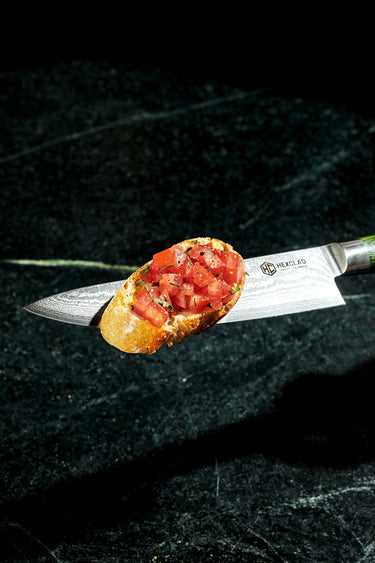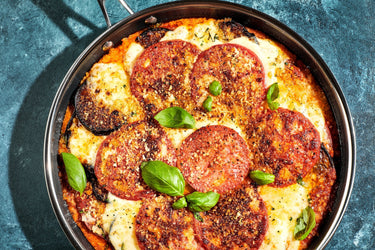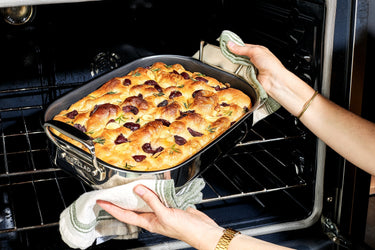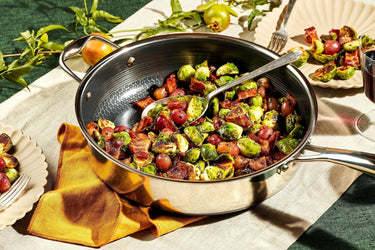Selecting the Best Kitchen Knife

Unlike the process of slicing and dicing, finding the right kitchen knife isn’t always so cut and dry.
In fact, selecting the right knives can feel more tricky than achieving a perfect julienne using a cleaver. That is to say that it’s possible (if not fully advisable), but you’ll probably need some guidance along the way.
And for the record, while you can technically use a cleaver or boning knife to achieve a matchstick-like cut, we don’t recommend it — there are plenty of other knives much better suited to such a precise job.
Today, we’ll give you the scoop on all the right knives to keep in your arsenal. Then, we’ll season this article by giving you a breakdown of all the highest-quality materials you should look for. Finally, we’ll garnish the article with a handy how-to on keeping those babies sharp so that they can handle even the toughest ingredients.
What Are the Types of Kitchen Knives Every Chef Needs?
There are knives that we need, and there are knives that we want.
Unfortunately, not all of us have the space or the price point to have the knife block of our dreams in our kitchens. Instead, we need reliable, ergonomic knives that will withstand the test of time.
We need the knives that all chefs, regardless of status, keep in their kitchens. The most expensive knife isn’t always the highest quality, and there’s much more to consider in terms of craftsmanship.
Certain knives are naturally more versatile than others, but that doesn’t mean some are inherently better. By having a variety of different knives, all with different specialties, you can ensure that every cutting technique stays on the table for you — that’s right, get ready to start julienning, chiffonading, mincing, and fileting with the best of them.
Some knives allow for more precision, while others focus on power. Any home chef knows you’re bound to deal with plenty of different ingredients, meaning your kitchen isn’t complete without the knives to match.
Classic Chef’s Knife
A good chef’s knife will work in many everyday cooking situations, whether you’re a pro chef or a home cook. Think of the 8-inch chef’s knife as your right-hand man — your personal sous chef, if you will. It’s generally the largest knife in the bunch of essentials, and it performs universal needs.
Remember when we mentioned that some knives excel at versatility? Well, look no further than the absolute workhorse that is the 8-inch chef’s knife.
With one of these in hand, you can dice, slice, and filet fish and meats with ease. That being said, you will need to make sure you find a brand that gives you a comfortable hold, as many brands choose aesthetics over the quality of use.
You can also choose to go with a full tang knife, where the blade extends through the handle and is somewhat visible, or a partial or hidden tang option. German-style knives are often full tang.
However, contrary to the German knife standard, other global knives made in other countries often don’t follow this custom. While there is much debate about this topic, the truth is that one type of knife is no better or worse than the other. The heft of the knife and distribution of weight is much more important than whether or not the blade goes all the way through.
If you’re only able to get one high-end knife and will shun the rest, or you want to start with one knife and work your way into a full chef’s collection over time, start here. A chef’s knife is the most commonly used (and most necessary) tool of them all.
For the best chef’s knife around, HexClad has you covered with our Damascus Steel 8” Chef’s Knife.
Serrated Bread Knife
A serrated bread knife is the easiest to identify since the blade has little ridges that are quite distinct, especially when compared to the smooth surfaces of other options.
A bread knife comes in when cutting, you guessed it, bread. The serrations on the razor-sharp edge will help you saw through the crust without compromising the fluffy center.
A serrated knife will come in handy for a variety of fruits and veggies as well. These blades are strong enough to cut through the finicky skin of a tomato without harming the delicate interior.
Similarly, it also makes quick work of roasts and deli meats without damaging the integrity of the texture.
Santoku Knife
Santoku knives are similar to chef’s knives, usually only differing in size by an inch or two. These tools are very common to see in Japan and much of Asia in place of other chef’s knives.
Whereas you’re likely to see a so-called “classic” chef’s knife in Western-style cooking, a Santoku knife is essentially a Japanese chef’s knife. Whether or not you frequently cook global cuisine, there’s plenty to love about this kitchen staple and its sharp, thin blade.
Even if you already own a chef’s knife, the Santoku stands out on its own. Due to its noteworthy sharpness and shorter blade, this Japanese-style knife lets you get that much more precise with your cuts. If you thought slicing through veggies was a breeze with a chef’s knife, just wait until you try a Santoku.
You can use this kind of knife for ingredients of any size, but it especially lends itself to cutting smaller vegetables flawlessly. There is some variety to Santoku knives, namely in whether or not they feature a hollow edge or dimples.
Any Santoku knife can work perfectly well, it’s just up to the individual chef what they prefer.
If you’re making a large meal for your family, think of the chef’s knife and the Santoku knife as a power duo. One will slice your meats and create perfect portions for the whole meal, while the other will create those beautifully even cuts on your carrots and onions to finish the dish.
Utility Knife
A utility knife is on the smaller side, usually around five inches or less, and works wonders for cutting fresh fruits and veggies. Those delightful fruit salads for brunch and carrots with wings wouldn’t be the same without this great knife. Due to the smaller size, it’s much easier to cut even pieces for your fruits and veggies.
Having a utility knife handy in your home kitchen will keep your fingers safe when cutting through strong, starchy veggies. We highly recommend adding this useful tool to your kitchen sooner rather than later.
Paring Knife
Paring knives do those really small (but no less important) jobs that other kitchen tools are just too large to master. For instance, creating a garnish is difficult to achieve with bigger knives due to the relative size of the ingredients.
You may not use a paring knife as often as other knives, but one attempt at deveining shrimp with a larger tool will show you how invaluable a paring knife really is.
Without one, you’re bound to have difficulty keeping the knife and your hands stable. As a result, your cuts and slices won’t be as precise, causing many of your ingredients to lose shape. Having a paring knife in your possession means that you’ll always have a small but mighty helper nearby, and the quality of your dishes is sure to improve as a result.
Always remember that you eat with your eyes first — when your dish isn’t as pretty as it could be, it might not seem appealing to your palette.
What Is the Best Material for Kitchen Knives?
Professional chefs and home cooks have both found that the knives listed above are the absolute necessities for a functioning kitchen.
Keep in mind that these are just a baseline of what you can keep in your knife block. There are tons of tools that you can add to your collection as you start to become more adventurous with your dishes.
The Rockwell Hardness Scale Explained
The Rockwell scale is a way of determining how strong your materials are. A professional metallurgist will perform this test to determine how deep or strong an indentation left by the material is. This depth will equate to a number on the scale and determine the strength of the metal.
Some of the strongest metals to use to create knives are carbon steel and stainless steel. High-carbon stainless steel and similar metals will not only create the strongest blades but will also ensure that your knife has enough durability to last a lifetime.
Both metals are less prone to rust or corrosion, so you won’t have to worry about how normal wear and tear will deteriorate your cutting edge. They also have the benefit of being easier to keep in their sharpest condition.
What Is Japanese Damascus Steel?
Japanese Damascus steel stands out most in that it is layered. This means the steel is poured and then folded onto itself to create striations and lines in the metal. It’s one of the most durable and robust options for a steel blade, in addition to being aesthetically pleasing.
These types of knives are prized for their look, but the strength of the metal should be considered too. You will be hard-pressed to find a tougher or sharper knife on the market. That’s why it was so important to us at HexClad that all of our knives have this feature.
Our cutlery is made from the highest grade steel using this traditional Japanese technique. By crafting our knives this way, we provide super sharp blades that look just as good as they cut. The knife-making process is an art form, and Damascus steel can help you make a masterpiece.
What Is Pakkawood?
Pakkawood is the ideal material to use for kitchen knife handles due to its simultaneous comfort and stability. The wood veneer is made using a strong core with top-tier wood wrapped around the center. This works to create a durable, strong, and lasting handle that will add practical beauty to your knife block.
Plastic or lower-grade wood would require a more rigid hold. As time goes on, this is likely to cause pain and discomfort. It could even make you avoid certain dishes to spare your hand from cramping or even lose interest in cooking altogether.
How We Make Our Knives
We pride ourselves on offering our customers perfection, and our knives are no exception. No kitchen is complete without a variety of high-quality, sharp knives that can slice through anything. That’s why we only offer knives that feature both Japanese Damascus type of steel and Pakkawood handles.
Here at HexClad, we wouldn’t dream of using any other wood else for our knives. After all, what’s the point of creating amazing blades if we don’t add the best handles? We never cut corners — so you can cut all the corners you’d like.
How Often Should You Sharpen Your Kitchen Knives?
Now that you know what types of knives to keep and what to look for, let’s talk about proper care.
We’ll discuss two main techniques today: sharpening your knives and honing them. Not only are the differences in the techniques important, but we’ll also cover how often you should expect to perform these rituals with your knives.
Sharpening vs. Honing Knives
It can be easy to confuse the two processes, but sharpening and honing your knives need to happen at different times and different frequencies.
Honing refers to the technique in which you straighten out your blade. This won’t sharpen your knife, but it will keep the blade in line. As you use your knives, the blade will start to bend and turn slightly, causing a shift in your slicing and dicing results.
While a curved blade can be a helpful tool, this isn’t the right time or place. You might not notice the difference with the naked eye, but it can make a significant change when you’re cooking.
You will want to hone your knives about once a month. Luckily, the process is quite simple. Take your honing tool, hold it with the point down, and run the knife down the sides. Be sure to start close to you, then move in the other direction. Run the knife along both sides of the honing tool so that each side of the blade is straightened out evenly. Wipe down your knife, and it’s ready to hit the cutting board.
Sharpening is a requirement for knives because the blade will not only dull over time, but will also get microsized chips and scratches that need to be buffed out. Sharpening your knives is a very meticulous process that you need to do with either a tabletop knife sharpener or, ideally, a whetstone — but it ultimately comes down to personal preference.
Sharpen your quality knife about once a year, as needed. To sharpen your knife, you will need to run the length of the blade either through the sharpener or against the stone. Either way, you will want to start away from yourself and bring it closer as you pull it through.
Once you’ve run the blade against the tool a few times on either side, wipe off any residue and dust, and then it’s ready to go. In addition, make sure to hand-wash your knives whenever possible to avoid dulling them.
Meet Your New Go-To Knives
HexClad is all about providing you with the knowledge and know-how you need to create the ultimate cooking experiences at home. The only way to do this is by providing quality products that will last you a lifetime.
We’re confident that this information will help you find the best quality knives and knife sets for you, then keep them in perfect condition for years to come.
Sources:
The Importance of the Chef's Knife for the Home Cook | Houston Press





